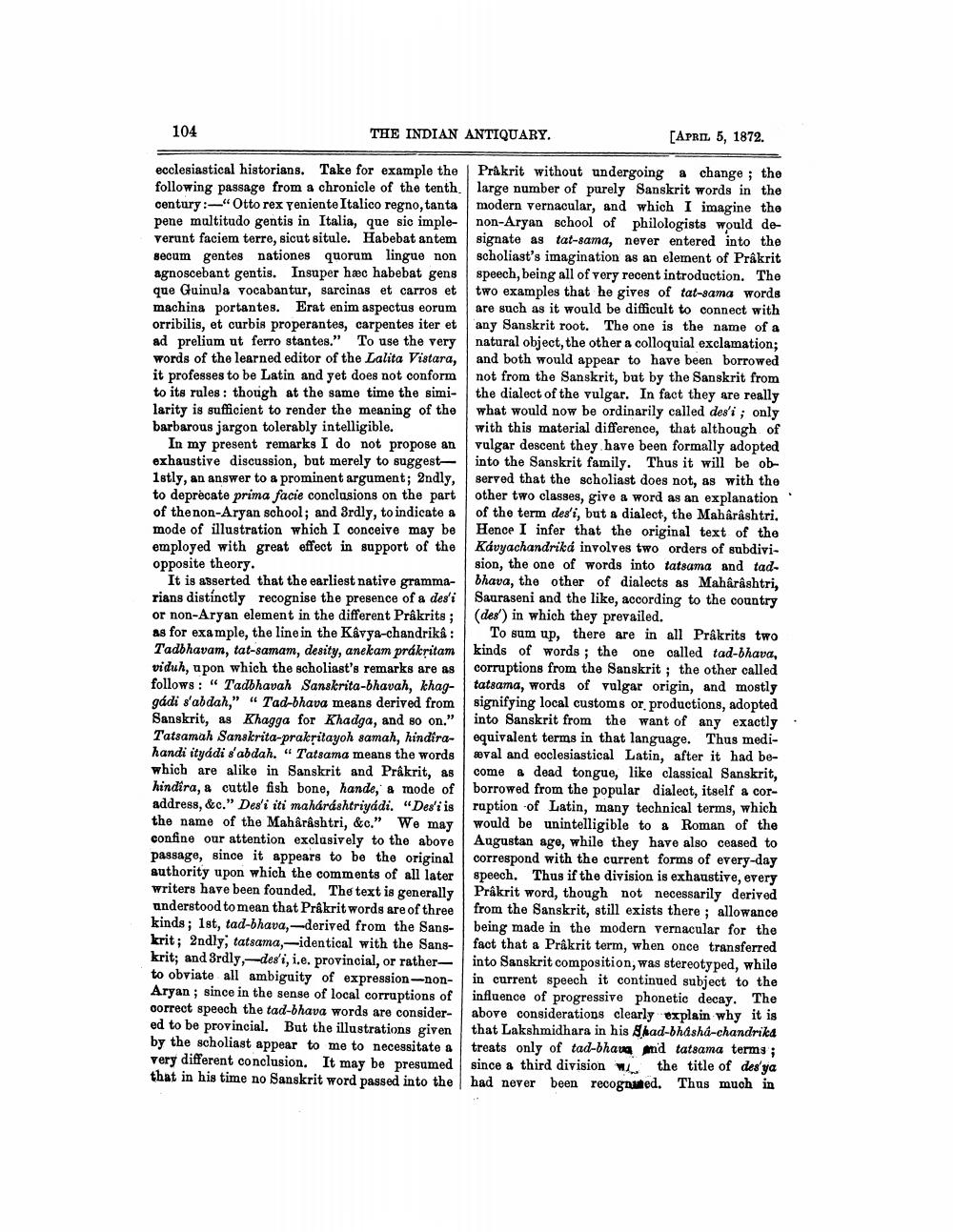________________
104
THE INDIAN ANTIQUARY.
[APRIL 5, 1872.
ecclesiastical historians. Take for example the Prakrit without undergoing a change; the following passage from a chronicle of the tenth large number of purely Sanskrit words in the century: "Otto rex yeniente Italico regno, tanta modern vernacular, and which I imagine the pene multitudo gentis in Italia, que sic imple- non-Aryan school of philologists would deverunt faciem terre, sicut situle. Habebat antem signate as tat-sama, never entered into the secum gentes nationes quorum lingue non scholiast's imagination as an element of Prâkrit agnoscebant gentis. Insuper hæc habebat gens speech, being all of very recent introduction. The que Guinula vocabantur, sarcinas et carros et l two examples that he gives of tat-sama worde machina portantes. Erat enim aspectus eorum are such as it would be difficult to connect with orribilis, et curbis properantes, carpentes iter et any Sanskrit root. The one is the name of a ad prelium ut ferro stantes." To use the very natural object, the other a colloquial exclamation; words of the learned editor of the Lalita Vistara, and both would appear to have been borrowed it professes to be Latin and yet does not conform not from the Sanskrit, but by the Sanskrit from to its rules: though at the same time the simi- the dialect of the vulgar. In fact they are really larity is sufficient to render the meaning of the what would now be ordinarily called des'i ; only barbarous jargon tolerably intelligible.
with this material difference, that although of In my present remarks I do not propose an vulgar descent they have been formally adopted exhaustive discussion, but merely to suggest- into the Sanskrit family. Thus it will be ob1stly, an answer to a prominent argument; 2ndly, served that the scholiast does not, as with the to deprecate prima facie conclusions on the part other two classes, give & word as an explanation of the non-Aryan school; and 3rdly, to indicate a of the term des'i, but a dialect, the Maharashtri. mode of illustration which I conceive may be Hence I infer that the original text of the employed with great effect in support of the Kávyachandriká involves two orders of subdiviopposite theory.
sion, the one of words into tatsama and tadIt is asserted that the earliest native gramma- bhava, the other of dialects as Maharashtri, rians distinctly recognise the presence of a des'i Sauraseni and the like, according to the country or non-Aryan element in the different Prakrits; (des') in which they prevailed. as for example, the line in the Kavya-chandrika: To sum up, there are in all Prakrits two Tadbhavam, tat-samam, desity, anekam prakritam kinds of words; the one called tad-bhava, viduh, upon which the scholiast's remarks are as corruptions from the Sanskrit ; the other called follows: “Tadbhavah Sanskrita-bhavah, khag- tatsama, words of vulgar origin, and mostly gádi s'abdah," “ Tad-bhava means derived from signifying local customs or productions, adopted Sanskrit, as Khagga for Khadga, and so on." | into Sanskrit from the want of any exactly Tatsamah Sanskrita-prakritayoh samah, hindira- equivalent terms in that language. Thus medihandi ityádi s'abdah." Tatsama means the words æval and ecclesiastical Latin, after it had bewhich are alike in Sanskrit and Prakrit, as come & dead tongue, like classical Sanskrit, hindîra, a cuttle fish bone, hande, a mode of borrowed from the popular dialect, itself a coraddress, &c." Des'i iti maharashtriyadi. "Des'i isruption of Latin, many technical terms, which the name of the Mahârâshtri, &c." We may would be unintelligible to & Roman of the confine our attention exclusively to the above Augustan age, while they have also ceased to passage, since it appears to be the original correspond with the current forms of every day authority upon which the comments of all later speech. Thus if the division is exhaustive, every writers have been founded. The text is generally Prakrit word, though not necessarily derived understood to mean that Prakrit words are of three from the Sanskrit, still exists there ; allowance kinds; 1st, tad-bhava,-derived from the Sans- being made in the modern vernacular for the krit; 2ndly, tatsama,-identical with the Sans- fact that a Prakrit term, when once transferred krit; and 3rdly, desi, i.e. provincial, or rather- into Sanskrit composition, was stereotyped, while to obviate all ambiguity of expression--non- in current speech it continued subject to the Aryan; since in the sense of local corruptions of influence of progressive phonetic decay. The correct speech the tad-bhava words are consider- above considerations clearly explain why it is ed to be provincial. But the illustrations given that Lakshmidhara in his bad-bhasha-chandrika by the scholiast appear to me to necessitate a treats only of tad-bhang md tatsama terms; very different conclusion. It may be presumed since a third division w. the title of des'ya that in his time no Sanskrit word passed into the had never been recognated. Thus much in
.




